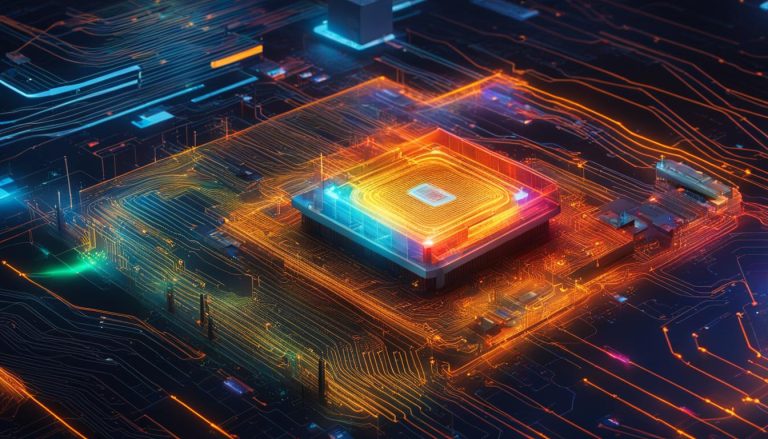Welcome to this informative article where I will shed light on the concept of underfitting in data science. As a professional in the field, I often come across this computational phenomenon that perplexes many. In simple terms, underfitting occurs when a model’s accuracy is disappointingly low, despite being trained on a substantial dataset.
Now, let’s dive deeper into the meaning and definition of underfitting. Underfitting refers to a situation where the model fails to capture the complexity of the data, resulting in poor performance. It’s crucial to understand the causes and implications of underfitting to tackle this challenge effectively.
Key Takeaways:
- Underfitting in data science refers to a situation where a model’s accuracy is low despite sufficient training data.
- Causes of underfitting include insufficient or poor-quality data, inappropriate model selection, overfitting or underfitting, and incorrect hyperparameter tuning.
- Underfitting can have implications in various areas, such as neural networks and deep learning, where complex patterns need to be recognized.
- To prevent underfitting, techniques like collecting more data, choosing the right model, increasing model complexity, and proper hyperparameter tuning can be applied.
- Understanding and addressing underfitting can lead to improved model accuracy and performance in data science tasks.
Causes of Underfitting in Machine Learning
Underfitting is a common challenge in machine learning that can impact the accuracy of models. In this section, we will explore the various causes of underfitting and how they can affect the performance of algorithms.
Poor-Quality or Insufficient Data
One of the primary causes of underfitting is using poor-quality or insufficient data for model training. If the data used to train the model is not representative of the real-world scenario, the model may not be able to capture the complexity of the problem accurately. This can lead to underfitting, where the model’s performance is subpar.
Inappropriate Model Selection
Another cause of underfitting is selecting an inappropriate model for a specific task. Different models have different levels of complexity and are better suited for different types of data or problems. If a simpler model is chosen for a complex problem, it may not have the capacity to capture the intricate relationships within the data, resulting in underfitting.
Overfitting and Underfitting
Both overfitting and underfitting can contribute to underfitting in machine learning. Overfitting occurs when a model is overly complex and learns to fit the training data too closely, resulting in poor generalization to new data. On the other hand, underfitting occurs when a model is too simple and fails to capture the underlying patterns and relationships in the data. Both scenarios can lead to underfitting and, consequently, low model accuracy.
Incorrect Hyperparameter Tuning
Hyperparameters play a crucial role in determining the behavior and performance of machine learning models. If the hyperparameters are not set correctly, it can result in underfitting. For example, setting the learning rate too high or too low in a neural network can impact the model’s ability to learn and generalize from the data accurately.
Understanding the causes of underfitting is essential for developing effective strategies to prevent it. By addressing these causes, data scientists and machine learning practitioners can improve the accuracy and performance of their models.
Implications of Underfitting in Data Science
Underfitting in data science has significant implications and can impact the performance of machine learning models. It is important to understand underfitting in comparison to its counterpart, overfitting. While underfitting occurs when a model is too simple and fails to capture the complexity of the data, overfitting happens when a model becomes too complex and learns noise instead of valuable patterns.
In the context of neural networks, underfitting can be particularly challenging. Neural networks are powerful models that excel at recognizing complex patterns in data. However, if the neural network architecture is not adequate or if the model is too simple, it may underperform and struggle to capture intricate relationships. This can result in reduced accuracy and predictive power. To mitigate underfitting in neural networks, it is crucial to design architectures that are capable of capturing the complexity of the data and to incorporate appropriate training techniques.
“Underfitting can be seen as an underwhelming performance of a model that fails to achieve the level of accuracy expected, ultimately limiting its potential for insights and predictions.”
Deep learning, a subfield of machine learning that focuses on neural networks with multiple layers, is also susceptible to underfitting. Deep learning models are designed to learn hierarchical representations of data, allowing them to uncover intricate relationships and provide highly accurate predictions. However, if the model is not complex enough or if there is insufficient data for the model to learn from, underfitting can occur. This can hinder the performance of deep learning models and limit their ability to extract meaningful insights from complex datasets.
Underfitting Examples
Let’s explore a couple of examples to better understand underfitting. Consider a simple linear regression model fitted on a dataset with non-linear relationships. If the model is too basic and assumes a linear relationship, it will likely underfit the data, resulting in poor predictions. In this case, a more complex model that can capture non-linear relationships, such as a polynomial regression, would be more appropriate.
Another example is image classification using a convolutional neural network (CNN). If the CNN architecture is too shallow or lacks convolutional layers, it may struggle to recognize intricate patterns in images, leading to underfitting. In this scenario, a deeper and more complex CNN architecture would be necessary to achieve better accuracy and performance.
Underfitting vs. Overfitting
Underfitting and overfitting are two common challenges in machine learning. While underfitting occurs when the model is too simple and fails to capture the complexity of the data, overfitting happens when the model becomes too complex and starts to learn noise instead of valuable patterns. Both underfitting and overfitting can result in poor model performance and reduced accuracy.
It is important for data scientists to strike a balance between the complexity of the model and its ability to generalize well to unseen data. By understanding the implications of underfitting and overfitting, data scientists can make informed decisions when designing machine learning models and optimize them for better performance.
How to Prevent Underfitting in Machine Learning
Preventing underfitting is crucial for improving model accuracy in machine learning. By implementing effective techniques, you can ensure that your models capture the complexity of the data and perform optimally. Here are some proven methods to prevent underfitting:
1. Collect Sufficient and Quality Data
Insufficient or poor-quality data is a common cause of underfitting. To prevent this, make sure you have a substantial amount of representative data for training your model. Additionally, ensure the data is accurate, reliable, and diverse, covering various scenarios and edge cases. Collecting more data or refining existing data can significantly enhance model accuracy and mitigate underfitting.
2. Select the Appropriate Model
Choosing the right model architecture for your specific task is vital in preventing underfitting. Consider the complexity and intricacies of your data when selecting a model. Avoid using overly simplistic models that may not have the capacity to capture complex patterns in the data. On the other hand, be cautious of using excessively complex models that could lead to overfitting. Finding the right balance is crucial to prevent underfitting.
3. Increase Model Complexity and Feature Relevance
If your model is exhibiting signs of underfitting, you can increase its complexity by adding more layers or neurons in deep learning models, or by increasing the number of parameters in other models. Additionally, including more relevant features can help the model capture the essential characteristics of the data. Experiment with different combinations of features and model complexities to prevent underfitting.
4. Optimize Hyperparameters
Hyperparameter tuning is a critical step in machine learning model development. To prevent underfitting, ensure that your hyperparameters are appropriately tuned. This includes optimizing learning rates, regularization parameters, batch sizes, and other relevant hyperparameters. Utilize techniques such as grid search, random search, or automated hyperparameter optimization algorithms to find the best hyperparameter values for your model.
5. Regularization and Early Stopping
Regularization techniques can help prevent overfitting and underfitting by adding penalties to the model’s loss function. Regularization methods such as L1 or L2 regularization can reduce unnecessary complexity in the model and improve generalization. Additionally, early stopping is a technique where training is stopped early if the validation error starts increasing, preventing the model from overfitting or underfitting. These techniques can be valuable in preventing underfitting.
Conclusion
In conclusion, underfitting is a common challenge in machine learning that can significantly impact model accuracy. It occurs when a model’s performance is low despite being trained on a substantial dataset. Several factors can contribute to underfitting, including insufficient or poor-quality data, inappropriate model selection, and incorrect hyperparameter tuning.
It is important to differentiate underfitting from overfitting, as they are both detrimental to model performance but stem from different causes. Underfitting can result in poor model accuracy, as the model fails to capture the complexity and patterns within the data.
To prevent underfitting, there are several techniques that can be employed. Collecting more data or improving the quality of existing data can enhance model accuracy. Selecting the appropriate model for a specific task is also crucial. Increasing the complexity of the model or providing more relevant features can help address underfitting. Additionally, proper hyperparameter tuning, regularization, and early stopping techniques can improve model performance and prevent underfitting.
By understanding the causes of underfitting and implementing effective prevention techniques, data scientists and machine learning practitioners can overcome this challenge and enhance the accuracy and performance of their models in various data science tasks.
FAQ
What is underfitting in data science?
Underfitting is a computational phenomenon in machine learning where a model’s accuracy is low despite being trained on a substantial dataset.
What are the causes of underfitting in machine learning?
Underfitting can be caused by factors such as insufficient or poor-quality data, inappropriate model selection, overfitting or underfitting, and incorrect hyperparameter tuning.
What are the implications of underfitting in data science?
Underfitting can result in poor model performance as the model is not able to capture the complexity of the data. It is also relevant in the field of deep learning, where sophisticated models need to capture intricate relationships in data.
How can underfitting be prevented in machine learning?
Underfitting can be prevented by collecting more data or improving the quality of existing data, choosing the appropriate model, increasing the complexity of the model, providing more relevant features, and proper hyperparameter tuning.
Cathy is a senior blogger and editor in chief at text-center.com.


